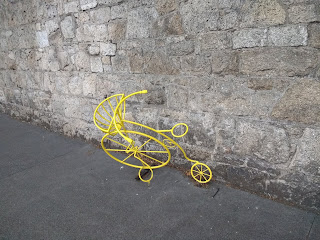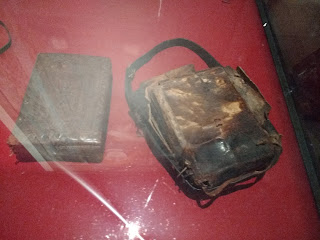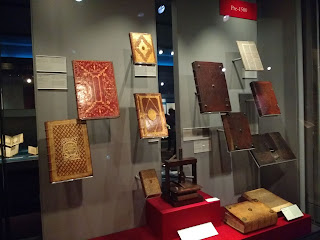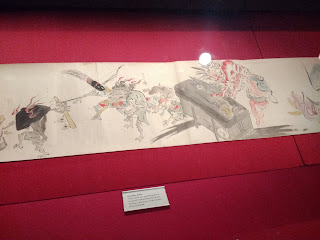Ahh, the beginning of another trip, this one leaving Denver on August 25th for a month in both the Irish Republic and Northern Ireland followed by two weeks in a small area of northern Wales, Scotland followed by a few days in London before heading home on October 9th. Most of you know we normally travel each fall for anywhere from three to more than four months so this six-week jaunt was a short trip for us.
We had to go for a walk even after not finishing our meal, so wandered along Drumcondra's High St., aka Main St.
Ogham stones, with their inscriptions that were probably a derivative of the Latin alphabetic system, likely marked territorial boundaries from the 5th to the 8th centuries. The inscriptions were combinations of one to five short lines and notches.
From an enlargement of one folio or page of the Book, we could see the symbols of the four evangelists: Matthew – the angel; Mark – the lion or calf; Luke – the ox; and John – the eagle. These symbols also represented the four stages of the life of Christ.
We strolled through St. Stephen’s Green en route to the National Museum: Archaeology which deserves its own post as much as for our memories as for showing off the treasures of Ireland from the Stone Age to the modern era with you. One of the most ferocious battles of the Easter Rising of 1916, when Ireland was seeking independence from British rule, took place in St. Stephen's Green during Easter week from April 24th -30th. Significant figures from Irish history and over 100 Irish Citizen Army Volunteers occupied this park as it was an important strategic location in the center of Dublin with intersecting roads and a water supply. While the Rising wasn't a military success, a Free State was achieved in 1922.
The Three Fates Sculpture was a gift from Germany to the Irish people for providing help to German children after WW II.
The dozen paintings in the Rotunda represented scenes from the early history of Dublin and some old city legends. The paintings have always been described as frescoes but they were actually murals as they were painted on dry stone.
Unfortunately, we had unknowingly spent too much time admiring too many fun Georgian doors, lollygagging on Grafton St, etc and thus found ourselves with far too little time at the celebrated Chester Beatty Library which has been called one of the best museums in Europe.
We flew nonstop to London and caught another nonstop not long after which got us into Dublin mid afternoon on the 26th. After a 90 minute bus ride from the airport into the city, we had a short walk, luckily, lugging our bags and weary bodies to our B&B which would be our home for the next three nights. The sight of the gorgeous flowers leading to our B&B in the Drumcondra area boosted my spirits!
The sight of differently painted doors also caught my attention as Dublin is especially famous for its brightly colored doors. These were just a teaser as we would see far more the following day.
I'm surprised either of us were still smiling when we sat down to eat at Fagan's Pub as we were pretty wiped out, but the food on British Air over to London had been the worst airline food we'd ever had so we were hungry. This was our first indication that Irish meal portions were huge - I've had to since request just half portions at breakfast ever since our first one, too!
The logo for Dublin City University which is primarily known for being the largest primary teacher training program in the country:
We found out the next morning the Irish breakfast consisted of eggs, 2 rashers or slices of bacon, 2 sausages, toast, Irish soda bread, small slices each of white and black 'pudding' that also looked like sausages, cooked tomatoes and often mushrooms, plus fresh fruit. I feel fat just listing all that! As I said, that was waaaay to much for both of us and, since everything is cooked to order, we could specify what we preferred.
We had reservations to see the Book of Kells at the country's premier university, Trinity College, so off we beetled. Since this was one of Dublin’s top sights, we'd bought tickets online about six months ago for an early timed entry hoping the crowds wouldn’t be too crazy then. I realized when we got there that the exhibit is so popular that it’s likely packed any time we might have chosen!
It's unknown when or how the Irish first came into contact with Christianity. There were enough Christians here in 431 AD for Pope Celestine to send them their first bishop. The most profound change Christianity brought was the introduction of writing. Pocket gospels were kept in satchels that could be carried easily by missionaries or were used for private devotions. Fewer than 20 gospel books have survived from the early medieval period and Trinity College Library had them all.
Of the 300 or so surviving Ogham stones, over 80 are known to be from County Kerry alone. Coincidentally, today we saw one listed on our map as we drove from Waterford to Kinsale and attempted to find it but, according to Google maps, it seemed to be in a farmer's field and we didn't fancy trying to climb over his fence and also deal with cattle and sheep, let alone the farmer's wrath, so had to give up. I hope we'll see one later this trip.
Considered to be one of the great treasures of medieval Europe, the Book of Kells was an illuminated manuscript written in Latin that was created by early Christian monks around 800 AD cloistered on the remote Scottish island of Iona that we’ll be visiting as part of this trip. Containing the four gospels of the New Testament together with various introductory texts and tables, the Book of Kells is regarded as Ireland’s finest national treasure for its extraordinarily rich and colorful decoration.
To produce the 340-page Book, the monks slaughtered 185 calves, soaked the skins in lime, scraped off the hair, and dried the skins into a cream-colored writing surface called vellum. Learning that must cause heartbreak for vegans! Once the vellum was created, the monks could use pens made from swan or goose feathers and begin writing. If mistakes were made, they could be scraped off the surface of the vellum with a knife.
It is unknown whether work was already underway on the manuscripts in 806 when Viking invaders pillaged Iona and killed 68 monks. The surviving monks fled to the Abbey of Kells near Dublin where scholars have debated if the book was made entirely in Iona or at Kells, or started in Iona and then finished at Kells. The book has been displayed to the public at Trinity College since the mid-1800s when it was brought for safekeeping.
Textual errors and the ornate nature of some of the highly decorated pages indicated to scholars the Book of Kells wasn't intended as a daily reading text but rather as altar 'furniture' for special occasions.
The most celebrated image in the Book was the Chi Ro page with Christ's name listed in the abbreviated Greek form. The page was filled with stunning visual reminders of the Eucharistic sacrifice and the resurrection of Christ.
The redhead turned sideways in the center may have been that of Christ himself. I have seen innumerable depictions of Christ but never as a redhead before coming to Ireland. It seemed fitting here of course!
Just to the right of Christ's head, two men facing each other were pulling out each other's beards.
After learning about
the Book, we entered a darkened room where no photography was allowed to
preserve the two gospels of the Bible that were on display. The gospels are
rotated so frequent visitors are lucky enough to view more than we did. The text
was elaborately decorated with vibrant blue, purple, red, pink, and green pigments.
The initial letters on the pages we saw were big and flowery, just as in a
children’s fairy tale book! The Latin calligraphy was all in capital letters and
followed ruled lines. Seeing at least a couple of original pages was a
fantastic sight – I could appreciate why tourists flocked to Trinity College to
see the Book.
Upstairs was the Long Room aka the Fagel Library comprising 200,000 volumes. As it’s a legal deposit library, it is responsible for maintaining a copy of every publication in the British Isles, including even children’s comic books which I found amusing!
As one hundred thousand books, magazines, etc are received each year, the Library has a back-up storage facility in the suburbs. Only the oldest books were kept here. The organizational system couldn’t have been simpler: the biggest books were at the bottom and the smallest up top!
Construction on the Long Room began in 1712 and 20 years later, the "grandest room in Ireland" was finished. Originally the room had a flat plaster ceiling and bookshelves on the ground floor only. To accommodate more books, the roof was raised in 1851 and the gallery of bookcases overhead was added.
The layout of the library was apparently similar to the Jedi Library in Star Wars!
The bays and shelves were labelled alphabetically with each book assigned a running number. Therefore a book classified as A.f34 was the 34th book on shelf 'f' in bay A. There was, though, no letter 'J' as there is no 'J' in Latin!
The library had one of a dozen copies of the Proclamation of the Irish Republic that was read at the General Post Office in central Dublin on April 24th, 1916, that started the Easter Uprising which eventually led to Irish independence from England. All seven signatories of the document were court-martialed and sentenced to death.
Another national icon was nearby, the oldest surviving Irish harp from the 15th century. In Celtic days, poets who were highly influential with kings and druid priests, would wander the land and unite people with songs and stories. The love of music is so strong still today that Ireland is the only country with a musical instrument as its national symbol. This harp’s likeness was on the back of Euro coins, on government documents, etc.
Marble busts of famous philosophers and writers, as well as certain men connected to the College, adorned both sides of the library.
As we were running short of time arriving at the Book of Kells, we didn't take time to appreciate Trinity University that was funded in 1592 by Elizabeth 1 to establish a Protestant way of thinking about God. Long the country’s most respected college, it was initially restricted to Protestant men although women were admitted in 1903 and Catholics received formal permission in the 1970s to study at Trinity by the Catholic Church; prior to then, they risked excommunication!
This was one of the stumps of the iconic Oregon maples that were planted in the square in the early 19th century and which lasted until June of 2018 when it collapsed. The tree rings indicated it was between 175-177 years old and were likely planted between 1841-1843.
Not far away was Merrion Square Park with a statue of Oscar Wilde lounging against a large boulder. He was surrounded by many of his clever sayings inscribed on other rocks.
Merrion Square was laid out in 1762 with elegant Georgian homes decorated with colorful doors surrounding the park. I was particularly intrigued by the doors as my parents used to have a poster of the Doors of Dublin hanging in their back porch in our family home in Ottawa. I was happy to be finally viewing likely many of those same doors several decades later!
Quite a few had historical plaques listing famous people who once lived within. Daniel O'Connell, known as Ireland's Liberator during the first half of the 19th century, resided here at #58 Merrion Square.
You might think we’d
had enough of looking at Dublin doors but no, we weren’t quite yet so we
continued on to Fitzwilliam Square to take in even more. The square was the last and the smallest of the five Georgian
squares in Dublin. 'Georgian' style, by the way, is British speak for Neoclassical and was named for the period when four consecutive King Georges occupied the British throne from 1714 to 1830.
I can't say I would normally be a fan of hot pink or turquoise doors but they looked spot on in this locale to give a bit of pizzazz to the very stately and proper Georgian homes. I couldn't help but thinking, too, that they had to cheer up its residents coming home on a typically rainy Irish day.
The park was a lovely refuge from the noisy city. One thing I've been surprised about since coming to Ireland a week ago now is the pride people take in their flowers as there seems to colorful and beautiful displays of flowers in both private and public gardens as well as in so many public spaces including motorways.
The large arch at the corner of the park was erected to honor British officers killed in the Boer War over the Empire's influence in South Africa at the very beginning of the 20th century. Locals dubbed it Traitors' Arch as most Irish sympathized with the underdog Boers.
Dublin street scenes that caught my eye and my fancy:
Not statues but men that looked like they were on Grafton St., Dublin's liveliest pedestrian shopping mecca and people-watching place! It was also the perfect place to hear minstrels singing Irish music as well as my all time favorite song, Hallelujah, by Leonard Cohen.
My father always used to sings Irish songs to me after I was tucked into bed. One I remember so clearly was the popular song Cockles and Mussels which, I discovered, has become a sort of unofficial anthem of Dublin. The song's tragic heroine, Molly Malone, and her barrow have come to stand as one of the most familiar symbols of the capital. She worked as a fishmonger but also as a working girl and died in one of Dublin's cholera outbreaks. The statue of Molly and her cart is affectionately nicknamed 'The Tart with the Cart' by Dubliners'!
Never did I expect to see so many palm trees all over Dublin and indeed all over southern Ireland, too, so far! This one was located by another Georgian building that was built in 1779 to exchange money but became City Hall in 1852.
As we stepped in its grand Rotunda, we could feel Dublin's glory days of the 18th century when the British Empire was at its height and Dublin became an elegant and cultured capital.
The 18-foot tall statue was of the aforementioned Daniel O'Connell who, in 1829, won emancipation for Catholics in Ireland from the much hated Protestants in London.
Nearby was Dublin Castle that was built on the sight of the first Viking Fortress and was also the seat of English rule in Ireland for 700 years. The British handed over power to the Irish here at the castle in 1922. The Castle is now used for official state and charity functions. Above the Castle gate was the statue of Justice.
In the Castle's courtyard was the Bedford Tower built in 1761.
Part of the Castle included the Dubhlinn Gardens named for the black pool or dubh linn in Gaelic where two rivers came together. The gardens were designed with a pattern of six interlocking brick pathways that were inspired by Celtic design that are apparently distinctive from the air. It was just fun watching children following the brick paths!
Named for a NY mining engineer, 1875-1968, who was in charge of the most important mine in our adopted home state of Colorado before becoming a mining magnate and one of the most successful businessmen of his generation, the library was a testament to Beatty's interest in collecting rare, ancient manuscripts and objets d'art from around the world.
He acquired important Islamic material including an exceptional collection of the Quran, and Mughal and Persian manuscripts.
The Beatty Library had 112 ages of St. Paul's collected letters, the man who was most responsible for spreading Christianity beyond Palestine.
Beatty was also a competitive force in the growing Oriental art market at the turn of the 20th century.
As he was disillusioned with both American and British politics after WW II, Beatty moved from England and relocated to Dublin at the age of 75 because he had roots in Ireland and was concerned that his massive collection would be broken up if he were to remain in England. He opened his own Library or museum to the public in Dublin in 1953. Beatty was the first to be granted honorary Irish citizenship four years later and the first private citizen in Irish history to be award a state funeral when he died in 1968.
Our first day in Dublin had lived up to all the hype and excitement that I'd heard about the city in the Emerald Isle! We looked forward to exploring much more of the city the next day.
Next post: Irish Emigration Museum, Kilmainham Gaol and more of Dublin.
Posted on September 2nd, 2019, from near Kinsale on Ireland's southeast coast.

























































































Lovely, Annie. As in Spain, reminds me of the strength of the old Christianity. The rest was lovely too, except for the hot pink door.
ReplyDeleteGood point, Andrew, about the comparison to the power of the Christian faith in both countries. Here in Kinsale on the island's southeast coast, there is a strong connection to Spain, something I wasn't aware of before.
ReplyDeleteGotten sort of used to the psychedelic doors AND buildings here in Ireland as there are so many of them!
Oh how I love the city of Dublin and this blog reinforced that love... the brilliantly coloured doors (Andrew, the hot pink colour is a tad too pink, but alas it makes me smile nonetheless :) , the beautiful and historic Trinity College and the endless energy and "happiness" of Grafton Street. And your descriptors and photos of the Book of Kells were illuminating...thanks for that ! xoxo
ReplyDelete